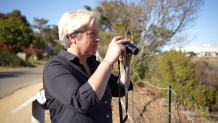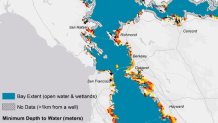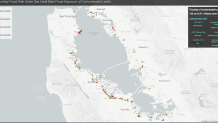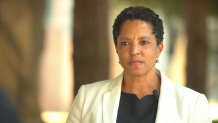Water rising beneath the ground, pushed up by intruding salt water as sea levels rise, now impacts thousands of toxic waste sites throughout the San Francisco Bay Area. A six-month investigation by NBC Bay Area found that the threat from rising groundwater isn’t decades in the future but, in some cases, may be imminent. In many hot spots from the North Bay to the South Bay, UC Berkeley scientists told the Investigative Unit they’ve recorded groundwater already at or near the surface. Aside from the threat of floods, that water may bring with it a host of toxins from sites the Investigative Unit documented years ago as part of the legacy of Silicon Valley: toxic chemicals, liquids, solids and gases long buried underground. Experts tell NBC Bay Area those toxic chemicals could now seep into homes and businesses during a storm, a high-water event, or as groundwater rises.

“It's coming up through the ground, so we can't see it,” said Dr. Kristina Hill, a UC Berkeley professor and landscape architect. Dr. Hill specializes in analyzing water movement in urban areas. She and her team discovered that, until recently, there has been very little scientific research that mapped the movement of water underground.
People could be exposed to this in a way that impacts their health, causes a miscarriage causes a cancer case right now.
Dr. Kristina Hill, UC Berkeley
“What we think of as a dry crust of land - it's not so dry anymore,” said Dr. Hill. She and her team studied data from water quality monitoring wells across the Bay Area and compared those numbers to ground elevation at each site. They looked at all coastal areas up to one mile from the current bay shoreline. The UC Berkeley team’s research shows that in many cases, rising seas are pushing up on the underground water table. The team’s data analysis identified many hot spots in north bay cities like Fairfield, Novato, San Rafael and Petaluma, where groundwater is already at the surface - or just a few feet below. The team also found high groundwater in Berkeley, Oakland and Alameda in the East Bay.

Areas highlighted in black show where water is already at the surface. Red highlights show groundwater is less than 40 inches below.
Local
The UC Berkeley team’s map also found plenty of high groundwater water in Silicon Valley cities like Mountainview, Redwood City, San Mateo and the rest of the peninsula. Dr. Hill says the results her team found and published now call for immediate action to prevent underground contaminants from coming to the surface. “People could be exposed to this in a way that impacts their health, causes a miscarriage causes a cancer case right now,” said Dr. Hill. “That could be happening during the wet seasons,” she said. “Not 2050, 2100 - now.”
This is a reality that can't be ignored any more.
Sherry Padgett, cancer survivor
Get a weekly recap of the latest San Francisco Bay Area housing news. Sign up for NBC Bay Area’s Housing Deconstructed newsletter.
“It's underground and it's affecting the water under us,” said Richmond resident Sherry Padgett, referring to the toxic chemicals documented right next door to her neighborhood.

Padgett became educated about the toxins contained in the Stege marsh near her home after she developed two cancers in one year. Though she admits she can’t prove it, Padgett is convinced that a 2002 project to clean up that site by digging out the contaminated dirt released chemicals that made her and her neighbors sick.
Documents obtained by the Investigative Unit show a wide array of chemicals routinely detected in monitoring wells at the Richmond site next to Padgett’s neighborhood. Included among those chemicals: arsenic, copper, lead, mercury, nickel, benzene, PCBs and DDT. The site had been occupied by chemical companies for decades.
Padgett survived a rare bone cancer that required removing many of her ribs and much of her left side. “When you lift my shirt…you can physically see my heart,” she said. After learning about Dr. Hill’s research, she told the Investigative Unit that she began to worry those toxins will rise again with the groundwater.
“The water is right here on high tide” Padgett said, pointing out her window to a spot just 50 yards away. This is a lake out here and high tides are rising. This is a reality that can't be ignored anymore.”
The chemicals that we worry the most about escaping from landfills are volatile organic chemicals, things like petroleum, fuel components, benzene, toluene, ethylbenzene,” said Keith Roberson, senior engineering geologist for San Francisco’s Water Quality Control Board. The board has identified 25 different landfills at risk of leeching toxic chemicals as sea levels rise. “It doesn't take too high of a concentration of some of these chemicals to render water unsuitable for drinking,” said Roberson.

All but two of those landfills are now closed but waste from decades of dumping remains. Roberson has sent orders to landfill managers to closely monitor the contaminated soil. Usually, the only barrier keeping chemicals from escaping what’s known as a “cap” – made with layers of clay, plastic sheeting, sand and vegetation. “Groundwater levels are going to rise and it is something that we're concerned about not only at the landfills, but also with the hundreds or thousands of other contaminated sites in the Bay Area,” said Roberson.

If we don't address this soon, we're honestly looking at a big catastrophe.
Sejal Choksi-Chugh, Executive Director, San Francisco Baykeeper
“Many of the areas where we see toxic sites, those cities are not actually even aware that those sites are going to be underwater soon,” said Sejal Choksi-Chugh, Executive Director of San Francisco Baykeeper, an environmental watchdog group that regularly samples contamination in the bay. SF Baykeeper found more than 1100 sites across the Bay Area which the organization says could release and spread toxic chemicals as the groundwater rises.

“If we don't address this soon, we're honestly looking at a big catastrophe,” said Choksi-Chugh. “The state is not acting fast enough. None of the agencies around the bay are acting fast enough. And they're not acting in a coordinated way.”
The agency in charge of cleaning up many of the toxic sites is the California Department of Toxic Substances, or DTSC. “We take our mission very seriously to protect human health and the environment,” said Meredith Williams, the Executive Director of DTSC.
In response to criticism from SF Baykeeper and other organizations that DTSC is not moving quickly enough to address the problem of rising groundwater, Williams said, “I understand the urgency about doing the work and…I can't convey that sense of urgency enough. We count on doing our work based on the best available science, and that sometimes takes time, which is very frustrating to the people who are impacted and to organizations who are watching this (clean-up work).”
While Williams admits she wants her agency to become more efficient, she points out that DTSC is responsible for up to 200,000 toxic sites across California. Williams also said that efforts to clean these contamination sites are often complex and expensive.

Some critics accuse DTSC of caving in to private business interests and not proactively stopping development to protect residents. In the marsh next to Sherry Padgett’s home, DTSC led a partial clean-up in one part of the marsh but opted to cap over the remaining contamination and not remove the rest of the toxic substances in the soil. The state has approved a plan by a local developer, allowing it to proceed with a multi-story housing project at the site.
Referring to the capping of the remaining contamination, a process used in Richmond as well as other contaminated sites, SF Baykeeper’s Choksi-Chugh was critical, saying it doesn’t go far enough to protect the surrounding community.
“That's a band-aid solution,” said Choksi-Chugh, “You need to actually be excavating the toxins out of these sites, cleaning them up to standards that are safe for public health.”
How much is it going to cost if we want to, for instance, dig up every speck of highly contaminated dirt and haul it away?
Meredith Williams, Director, Department of Toxic Substances
But DTSC’s Williams said it’s not so simple and that many costs and impacts, both financial and environmental, must be part of the decision on how to mitigate the toxic sites.
“It's a question of how it pencils out,” said Williams, speaking about toxic sites in general. “How much is it going to cost if we want to, for instance, dig up every speck of highly contaminated dirt and haul it away? Is it worth the carbon and the diesel fuel and the emissions that would be required in a neighborhood that might already be burdened by other polluting sources?”
Other state and regional experts on the front lines battling climate change tell the Investigative Unit that this rising groundwater poses such a serious threat to current toxic sites, they believe parts of the Bay Area may have to be abandoned and returned to the bay waters, a process called “managed retreat” It’s a very controversial idea that would have some landowners losing their land or developments to move out of an area that is at risk. But it’s an option that some experts say may be forced upon policy makers because the threat of toxic chemicals rising with the groundwater.
After beating two cancers, Sherry Padgett is determined to spread the word about the dangers posed by the toxins underground as water rises.
“When I talk to people about the site (next to her home), I say the only thing I ask is that you tell two more people,” she said, “and if you tell two more, tell them to tell two more. And that's how we will know more together. And we'll get out of this ditch we're in. Because it really is a big mess.”



